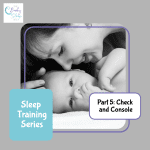
Today, I will start a series of posts outlining the variety of sleep training methods that I recommend. I will post them in order from no (or very little) crying to the most (potential) crying. There are many variations to these methods, so I am only going to highlight the main gist of each method. Every parent can add tweaks here and there to accommodate their unique style and situation. At the end of the series, I will tell the story of my first son and, eventually, my second. So, let’s get started! I’m anxious to share this information!
Why Sleep Training?
The primary goal of sleep training is to help your baby learn how to fall asleep on their own. We often do not give babies enough credit that they can learn to do this when they are very young. Habits become harder to break as they get older, and I have had people tell me that even waiting until 8 months has felt too late. It is also important to understand how sleep associations work and why they are often the only thing standing in your and your baby’s way of getting a good night’s sleep. In the same way that sleep deprivation and sleep fragmentation are hard on you, it can be hard on your baby, too. Not enough sleep can lead to obesity and other sleep problems, as well.
When Should You Start Sleep Training?
If you have an “easy” sleeper, you probably already had it done at just a few weeks old. Some babies simply start sleeping all night! I have said before, this website is not really geared toward parents of those babies. It’s simply not that easy for all of us.
For newborns, it never hurts to try to put down your baby when they are still awake. Then, see if they will drift off unassisted. And, we outline newborn-friendly sleep coaching approaches in our e-book, Essential Keys To Your Newborn’s Sleep. As always, this depends on the baby, as usual, I urge you to decide for yourself when the “right” time is.
It has to be right for you and your baby and you know your baby best. You must be in a place where you can 100% stay consistent and stick with it. That is an important step in any and all methods you choose. I have seen some parents start as early as 8-10 weeks and I’ve helped others get their 3-7-year-old sleeping all night.
That is an important item to note. Some people believe that all kids will grow out of not sleeping all night. I’m sure you’ve seen commercials for drugs that help adults sleep such as Ambien or Lunesta. Your child may or may not outgrow these sleep problems and they become habits more than anything.
Although babies go through sleep regressions, I always urge parents to look at the habits they may or may not help foster. Sure, it might be normal for some night wakings throughout babyhood, but when your baby is waking up every 1-2 hours for a bottle or rocking in a rocking chair, this is not “normal” and not good for them. We ALL feel better on as little sleep fragmentation as possible and that includes your baby.
What’s My First Step in Sleep Training?
Your first step in sleep training is developing a bedtime routine. Children thrive on routine and it sets expectations so they know what’s going to come next. If every night is different, it does not cue them that the day is coming to a close and that their body should start to relax and get ready to go to sleep. When done right, part way into the routine, your child will probably start to get very sleepy because they are associating certain actions with going to sleep. A routine also helps when you are away from home on vacation or a special outing because the routine is the same.
What Does A Bedtime Routine Include?
The bedtime routine is up to you and your child and what they like or dislike, but a typical routine might include diaper and pajamas, a quiet game, teeth brushing, potty (if applicable), a book (or 2), singing, and cuddling, and then lights out.
I purposely missed a bath in the routine. I did that for a couple of reasons. Some people don’t want to or can’t give a bath every day and the other reason is if you have a spirited child like mine, a bath might actually have the opposite effect and rile up your child. For many kids, though, the warm water is relaxing, but for others, the warm water and then the cooling off actually hype them up a bit. In that case, you might just have a longer routine than others.
For more details about how to find the perfect bedtime routine and examples…
Step 2 in Sleep Training
Proceed to Step 2 in Sleep Training








